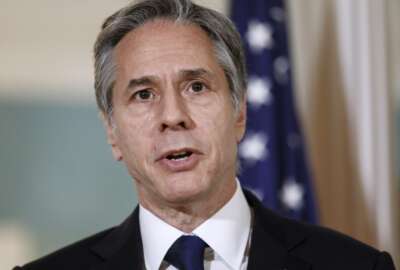A quarter of State Dept. facilities need serious maintenance, backlog growing
The maintenance backlog stands at about $3 billion and the number of facilities is growing faster than the budget.
Best listening experience is on Chrome, Firefox or Safari. Subscribe to Federal Drive’s daily audio interviews on Apple Podcasts or PodcastOne.
One in four State Department embassies and other facilities are, in the department’s own estimation, in terrible shape. In fact the maintenance backlog stands at about $3 billion. The number of facilities is growing faster than the budget. Is there a way out? For some possible answers, Federal Drive with Tom Temin turned to two auditors at the Government Accountability Office. Catina Latham is acting director for Physical Infrastructure, and Jason Bair is director for International Affairs and Trade issues. They discussed some of their findings on State Department facilities.
Interview transcript:
Jason Bair: For your listeners context a little bit here, I think most of them can imagine in their minds at least what a U.S. embassy is like overseas. But just for context, that only accounts for about 300 of the facilities that we really are looking at. But the State Department actually has a portfolio of more than 8,500 facilities and properties all across the world. And so, yes, that’s the iconic embassy that many people would think of, but it’s also things like ambassadors residences and staff housing and warehouses and recreational facilities. It’s all a broad manner of things that the State Department owns and maintains overseas. And so I think the bottom line that we were seeing is that the State Department needs to do a much better job of paying attention to planning and budgeting for maintaining those facilities overseas. As you mentioned in your overview, the number of facilities really is outpacing the funding that they have in order to do maintenance. And we saw a couple of key drivers in terms of the growth of the State Department’s overseas portfolio. One is that since the bombings in Nairobi and Dar es Salaam, the State Department has built a lot of new embassies to try to get our people in safer, more secure facilities. And when they’re building these new embassies, they tend to be larger than the ones that they were replacing, because they’re built to last for five decades or so. And they assume a certain amount of growth. For example, one of the things that we talked about in the report was in Kosovo, we replaced 91,000 square feet with 125,000 square feet new facility.
Tom Temin: With respect to this maintenance backlog in this 25% of facilities that are below par, or some of them are falling apart, does that includes some of those facilities built under the construction program that now dates back about 20 years?
Jason Bair: Yeah, it includes a combination of both. And in general, as with houses the people own and things like that, newer facilities are typically in better condition. But what we’re finding is that as some of those first round of kind of new embassies are getting older and older, 15 to 20 years old, they’re having issues with many of their major maintenance systems, their operational systems — air conditioning, heating, ventilation, things like that — just like people would in a house.
Tom Temin: Sure. And one of the statistics in your study shows that the deferred maintenance grew by a factor, if I did my math right, by 30 in the couple of last two fiscal years, to $3 billion. How did that happen? How does it grow so fast?
Jason Bair: I think Catina looked really closely at that one. You want to talk about that a little, Catina?
Catina Latham: Oh, yeah, sure. I mean, as you noted, the […] backlog grew from $96 million in 2019 to $3 billion in 2020. And there were several things that are attributed to that group. First and foremost, they use an older methodology for the past data that relied on survey of facility managers. So that data wasn’t quite complete. And for the 2020 data that we presented those $3 billion, the new methodology included supplemental surveys, so they did some modeling to estimate the maintenance needs for the key building system. So that just meant that they had a much larger backlog than they knew about until they put in this new methodology. They need a plan in place and budget for how to address this backlog.
Tom Temin: We’re speaking with Catina Latham. She’s acting director of Physical Infrastructure issues, and with Jason Bair, director for International Affairs and Trade issues at the GAO. Give us an example, because we’ve talked on the show with State Department about some of the shiny, wonderful new projects they’re doing, like the new overhaul and addition of buildings in New Delhi, but what are some of the problems that stand out in particular that might be seen by the public’s of the nations where the State Department is hosted?
Jason Bair: I would just point out one great example, the Embassy in Manila, the Philippines, it dates back to 1940. They have problems with their roof, with their air conditioning, with plumbing, electrical. And because it’s built in a coastal site, it’s subject to flooding on occasion. These are all major problems for how they have to address the maintenance
Tom Temin: Catina?
Catina Latham: Yes, I would certainly add to that, as Jason pointed out, really, the older the buildings, the more historic properties like, Tom, that are in Rome, also do have the issues with pipes and breaks and leaky windows. So those just are some of the examples that we saw with some of the buildings.
Tom Temin: And I looked at a chart in this report and it showed that the ambassadorial residences, as a group of types of structures, seem to be in the worst shape, or most of them are in bad shape. And that’s really rough on the diplomatic corps though, isn’t it?
Jason Bair: Yeah, you’re exactly right. What we found was that more than half of the ambassadorial residences are actually in poor condition. And why that’s important is because these ambassadorial residences really serve a couple of purposes. Obviously, they’re the home for the chief U.S. diplomat in the country, but they also serve a really important representational purpose. It’s a place for ambassadors to convene people from across the country, and spark dialogue and have great conversations, and host events to celebrate democracy and all the wonderful things that U.S. diplomats do overseas. I think an example of this that really stuck out for us was we found that the ambassador’s residence in Nairobi, Kenya dates back to 1934. And its kitchen was in total disrepair to the point where they were using it to store furniture. And so as a result, the residence hasn’t even been occupied since 2019. So not only do we lose the ability to use that facility, we now have to lease a new place for the ambassador to live.
Tom Temin: Yeah, so that’s almost as bad from a diplomatic standpoint as serving bad American wine or something from a strange state. Alright, so what are your recommendations here? How can State get out of this? They’ve got $3 billion in needs they don’t have in funding, and they’ve got 25% of their facilities in poor condition. What are you recommending here?
Catina Latham: Oh yes, I can certainly respond to the recommendations from the report. We recommended that State develop a plan and specify the funding that’s needed to address this backlog that we identified. We also recommended that they use predictive modeling to effectively analyze their potential resource investments. And then also too, to use mission critical information to help them target their maintenance for investments. So these were three of the total five recommendations that we […] State Departments.
Tom Temin: It seems like they need a system to be on top of maintenance. That is to say you don’t replace a roof when it starts leaking. But roofs have life cycles, there’s 1,000 consultants that can look at a building and tell you what you’re going to need next, and when you’re going to need it. And so it seems like they need to do some proactive planning and budgeting before things fall apart, it’s fair to say?
Jason Bair: We certainly think that they need to do a better job of being proactive about these things and staying on top of them. Because as we all know, with our houses, if you allow a little problem like a leaky roof, which wouldn’t cost much to repair, you allow that to go on for a little while, and you defer maintenance on that, you end up with bigger, much more expensive problems.
Tom Temin: And how did the State Department take the recommendations? I would imagine they agreed with these ones.
Jason Bair: Yes, they agreed to implement the recommendations. Admittedly, these are things that are going to take a little time, and they’re going to take trade offs to figure out exactly what the right next steps are, especially as compared with the embassy construction program. But we’re confident that they’re going to make progress.
Tom Temin: And I guess you’ve probably answered this in one way or another, but you mentioned in the report the idea of managing deferred maintenance backlogs. Which kind of sounds ironic, but there is a methodology that’s accepted for doing that. And he said State mostly does a good job of managing the deferred maintenance backlogs. What does that actually mean?
Catina Latham: So they have a methodology they have in place to determine the condition for their property. And these conditions are, the formula they use that includes both the repair needs, and whatever replacement costs it would be for that. And so once they do this formula, they put a term or they deem what’s an acceptable condition. And so for now, State has said anything that’s above 70% is at acceptable condition. So that’s 70% of what would be considered core. And they have core and good as part of these areas. And so that’s the formulas that they put in place to determine what would need to have maintenance, what’s in poor condition. And we noted in our report that over a quarter of the properties were in poor conditions, but when you exclude properties that have been in place for just the past […] year, that’s over 50% of the properties that are in poor condition. So just further stressing the point that State needs to address their deferred maintenance costs. And overall to point out examples that we put in place, or noted earlier that the more you delay these from, the more expensive they will be.
Jared Serbu: Catina Latham is acting director for Physical Infrastructure, and Jason Bair is director for International Affairs and Trade issues, both at the Government Accountability Office.
Copyright © 2025 Federal News Network. All rights reserved. This website is not intended for users located within the European Economic Area.
Tom Temin is host of the Federal Drive and has been providing insight on federal technology and management issues for more than 30 years.
Follow @tteminWFED






